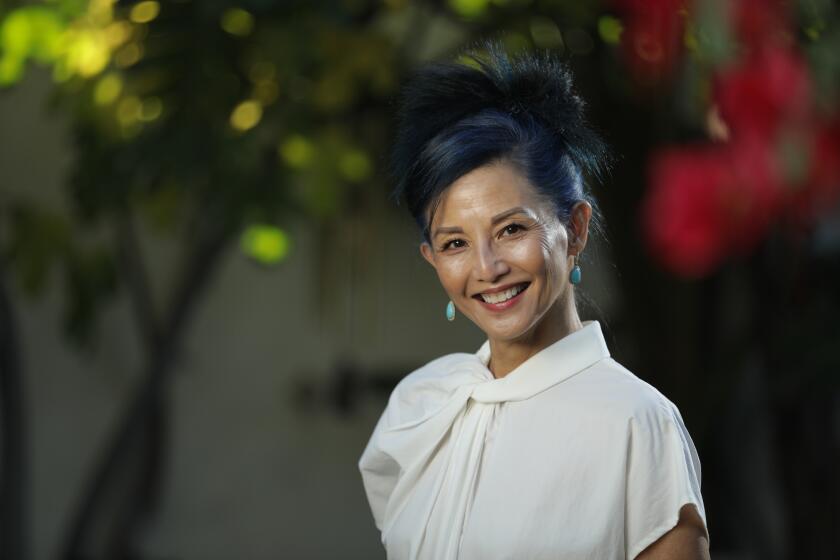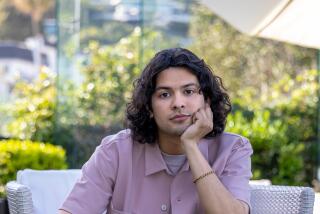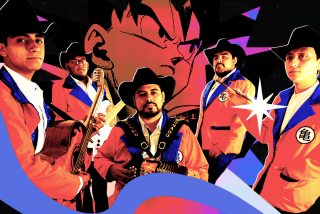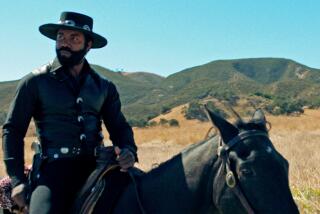At Netflix, ‘Cobra Kai’ broke out. Now its whiteness is under a new spotlight
- Share via
Fans have quoted it for decades: “Sweep the leg!” “Get him a body bag!” “Wax on, wax off.” Now, more than 30 years after “The Karate Kid” crane kicked its way into pop culture history in 1984, the mythos has been reborn for the digital age.
Make that reborn again. After debuting on YouTube Premium in 2018, breakout spinoff “Cobra Kai” last year moved to Netflix, where the series, whose third season premiered on the platform New Year’s Day, received more attention than ever. (Season 3 was originally produced for YouTube before the company shifted its original programming strategy.)
Ralph Macchio still remembers the moment it sank in that he’d get to come back for more as Daniel LaRusso, the scrawny San Fernando Valley teen befriended by Noriyuki “Pat” Morita’s martial arts master, Mr. Miyagi. “[Producer] Jerry Weintraub put his arm around me at the end of a screening and said, ‘We’re gonna be making a couple of these,’” said Macchio, now 59.
The sleeper hit spawned sequels, including the Okinawa, Japan,-set “The Karate Kid Part II” in 1986 and “Part III” in 1989. A Saturday morning cartoon even reimagined Daniel and Mr. Miyagi as globe-trotting adventurers. But by the time a fourth film was made — 1994’s “The Next Karate Kid,” starring Hilary Swank — Macchio and onscreen rival William Zabka, as blond bully Johnny Lawrence, were looking to branch out.
William Zabka’s Johnny Lawrence never left the San Fernando Valley circa 1984. And Netflix’s “Karate Kid” sequel plays with that disconnect brilliantly.
Improbably, the duo have slipped back into their roles decades later on “Cobra Kai,” in which the middle-aged Johnny — a down-and-out alcoholic stuck in the glory days of his youth and still stinging from his defeat at the ’84 All-Valley Karate Tournament — takes on his own teen protege, Miguel Diaz (Xolo Maridueña), and reopens the dojo where he learned his all-American style of “No Mercy” karate. Daniel, meanwhile, is a bonsai-pushing car salesman milking his karate glory to promote his business. The students have become the teachers — but are either of them their best selves?
“For me, as much as the show is karate-centric, it’s not about karate,” said Zabka, 55, who has added work behind the camera to his resume in the intervening years, nabbing an Oscar nomination for the 2003 short “Most.” “It’s about humans. It’s about adults trying to find their way, putting things behind them, struggling. And that’s what every character in the show has in some way.”
Likable characters, high-energy fights, suburban melodrama and ‘80s dad-rock have fueled the three seasons of “Cobra Kai,” with a fourth already planned — and its semi-satirical approach to slinging nostalgia while expanding the “Karate Kid” mythology into a multigenerational saga has proved popular. On YouTube, the first episode has amassed more than 98 million views, and the third season swiftly unseated steamy Regency-era romance “Bridgerton” in Netflix’s ranking of its top 10 TV shows.
For creators Jon Hurwitz, Hayden Schlossberg and Josh Heald, spinning the films they grew up on into a fresh narrative — and dreaming up new characters, like Daniel’s teenage daughter, Samantha (Mary Mouser); Johnny’s estranged son, Robby (Tanner Buchanan); and Cobra Kai’s star student, Miguel — has allowed them to dive ever deeper into surprisingly poignant themes.
Examining how Johnny and Daniel remain chained to the past, for example, was a fertile springboard for contrasting how their worldviews had diverged so starkly. “We try to approach our characters not from a place of judgment but from a place of understanding,” said Hurwitz. “And by doing that you’re allowing for the possibility that anyone has the potential to grow and anyone has the potential to evolve and progress in this world.”
In the series’ heightened, karate-obsessed version of the Valley, ex-jock Johnny teaches his aggro style to a school of misfits while Daniel revives Miyagi-Do in his late mentor’s memory. As their bitter rivalry escalates, “Cobra Kai” explores more complex emotions as characters learn the hard way that there are no bad students, only bad teachers — and that violent karate brawls do, in fact, have grave consequences.
To play Kumiko again 34 years on, Tomita told the Netflix series’ creators she’d need to “inject a truer picture” of the character’s heritage — and her own.
For its next-gen stars, the series is already opening doors, especially with the jump to Netflix.
“‘Cobra Kai’ has been a huge shift for me, career-wise,” said Mouser, 24, who hadn’t done stunt-intensive work until being cast as the next LaRusso and jumped at the chance to don a gi when her character reignited her love of karate in the second season. “No matter who it was, we were all treated as equals and as fellow creatives, and that was a turning point for me: This is what it feels like to have my voice heard and to feel like I’m cocreating this character.”
Like his cast mates, Buchanan, 22, saw his social media following skyrocket when the show hit Netflix. After a decade of credits including “Designated Survivor” and “The Fosters,” his portrayal of misunderstood karate prodigy Robby brought new opportunities. Buchanan is now looking for projects to produce and wrapped a lead role in Miramax’s “He’s All That,” a gender-flipped remake of “She’s All That.” “I know I got that meeting a little bit,” he said of the producers, “because they were like, ‘We just binge-watched “Cobra Kai”.’”
Maridueña, 19, made his screen debut on “Parenthood,” a show he credits with turning acting from something to do to pay for college into a full-on career. The native Angeleno landed the role of Miguel, the neighbor kid who eagerly strikes up a LaRusso/Miyagi dynamic with Johnny, during his own junior year of high school. It’s not lost on him that when he won the “Cobra Kai” role, his casting was heralded as a groundbreaking role for a Latino performer. Now his goals include getting behind the camera and powering his own inclusive projects.
“While I would love that inch to turn into a mile. It needs to be just the beginning,” he said. “The stories that I want to write are stories that are authentic to the people that I grew up with.”
The key to the series remains its deft interweaving of past and present with the DNA of the original films. After bringing back “Karate Kid” villain John Kreese (Martin Kove), who promptly orchestrates a hostile takeover of Johnny’s students, “Cobra Kai” doubles down on the sadistic dojo founder’s Vietnam War backstory in its third season.
Kreese’s elevation, and the heightened scrutiny that comes with being embraced by one of the most powerful companies in Hollywood, also underscores the fact that there are now three white men at the center of “Cobra Kai,” a franchise rooted in and deeply indebted to Eastern tradition. Morita, who earned an Academy Award nomination for his performance in the first film and died in 2005, appears in flashbacks in the series, and both Yuji Okumoto and Tamlyn Tomita reprise their roles — as Daniel’s rival and ex-flame, respectively — from “Part II” in Season 3 guest arcs. Supporting characters of color also saw expanded roles in the new season. But after 30 episodes on two platforms, “Cobra Kai” has yet to cast an Asian lead.
It has been 30 years since “The Karate Kid Part III,” and Ralph Macchio is still alive — and kicking.
“Except for the Latino character of Miguel, all the other people of color are outside of that main cast, so it actually doesn’t show as a diverse show in a sense,” said Ana-Christina Ramón, coauthor of UCLA’s annual Hollywood Diversity Report, which designates leads as the top eight credited regular actors. (Across the industry, the report found that white characters made up 75.9% of the leads in digital scripted series like “Cobra Kai” in the 2018-2019 season, while 5.9% of leads were Latinx, 4.7% were Black and just 1.8% were Asian.)
A number of critics have taken notice of the series’ whiteness as well: Salon culture senior editor Hanh Nguyen, who has been critical of the series in the past, told The Times that “the only main character of color who has any sort of interiority is Miguel.” “Danny LaRusso, Italian kid from Jersey,” as Vanity Fair’s Sonia Saraiya put it about the first two seasons, “is the most Japanese character on this show.”
As Times TV critic Lorraine Ali writes, “Cobra Kai” has successfully mined laughs and pathos from Johnny’s transformation through his proximity to an immigrant family. It’s also scrutinized how Kreese’s brand of karate perpetuates a cycle of militant toxic masculinity. But it has been slow to explore Daniel’s own blind spots beyond a moment of clueless “sushi-splaining” and his bewilderment that his karate-chopping commercials might be seen as cultural appropriation.
“The thing I’d like to see them do is to go beyond this suburban idyllic space, this white pocket dimension, more deeply,” said writer and podcaster Jeff Yang, who has covered the series for Quartz. “What if they actually did encounter people who embraced martial arts not just to overcome bullying, but because it’s part of a larger tradition that exists within people of color communities?”
Sending Daniel back to Okinawa in the third season to reunite with Kumiko (Tomita) and Chozen (Okumoto) is a step in that direction, allowing the show to “feel what was missing,” said Heald. “To acknowledge that there’s a big missing piece because of Mr. Miyagi and come to the point of appreciating that it’s not just Mr. Miyagi, it’s everything that he touched and that touched him.”
The Times TV team selects the 15 shows we’ll be watching when they premiere or return in 2021.
The return, which Macchio himself had pushed for and on which Tomita and Okumoto consulted, results in some of the series’ most resonant payoffs. “I wanted him to evolve as a character,” said Okumoto of the once dangerously prideful Chozen. “I didn’t want him just to be there as a person to push the story along. I wanted him to go through a journey, to go through a soul-searching.”
Heald, Hurwitz and Schlossberg, who are writing the fourth season, say they’re well aware of the criticisms. “Having made ‘Harold & Kumar Go to White Castle’ we’ve been particularly sensitive to Asian American representation in movies and television,” said Schlossberg of the 2004 comedy, starring John Cho and Kal Penn, which he cowrote with Hurwitz. While there are no writers of Asian descent on the “Cobra Kai” writing staff, the trio emphasized that when it comes to elements such as Gōjū-ryū karate, on which the Miyagi-Do style is based, and certain Japanese cultural details, they have leaned on actors like Tomita, Okumoto, stunt coordinator Hiro Koda and original “Karate Kid” screenwriter Robert Mark Kamen for guidance.
“We would have loved if there was a Miyagi son or daughter that was floating around in the lineage and the canon of the movie to play with,” said Heald. “But we inherited the story that felt like the natural continuation, where for better or worse you are dealing with Johnny and Daniel as your protagonists.”
Maridueña, who credited the showrunners for thoughtfully integrating Ecuadorian heritage into Miguel’s story, acknowledged that the world of “Cobra Kai” doesn’t always reflect the diversity of its San Fernando Valley setting, which according to 2019 U.S. Census figures is 42% Hispanic. “If you live in the Valley, and really the greater Los Angeles area, you know there are so many different Latinos, Black people, people of Asian descent,” he said. “And while our show is catching up, I think a lot of shows, like everything in Hollywood, feel like they’re catching up slowly.”
Schlossberg cited casting limitations in Atlanta, where the show is filmed. “When it comes to background casting, we are limited [in] making a high school on our show look exactly like a high school would look in Reseda,” he said. (According to U.S. Census figures, Hispanics make up 5% of the population of Atlanta and 10% of the population of Georgia, while Asians make up 5% of the population in the city and 4% statewide. Atlanta is 48% Black, while Georgia as a whole is 32%.)
Yet visual representation such as that seen in the hallways of a high school is just the first step toward meaningful representation, said Ramón. “Do you get to hear their stories being told? Meaningful representation means you get to find out the person’s story from their perspective.”
As they ride their Netflix bump into the first season produced in COVID-19 times and under the streamer’s banner, the creators declined to comment on details of upcoming seasons. They did, however confirm that introducing characters of Asian descent “is definitely something that is in our plans going forward” and teased the possibility that familiar faces like Aisha, the kindhearted Cobra Kai student (played by actress Nichole Brown) who was conspicuously written out of Season 3, could very well come back to West Valley High in the future. “Any character who has appeared in the ‘Karate Kid’ universe has the potential to return,” said Hurwitz.
Making more seasons means more chances to bring in new characters, they say. “Each season as we’re writing, we’re looking for new underdog stories and new characters to populate the universe,” said Heald. “We always have our eye towards representing today’s society as richly and as accurately as possible.”
They’re gonna be making a couple of these.
‘Cobra Kai’
Where: Netflix
When: Any time
Rated: TV-14 (may be unsuitable for children under the age of 14)
More to Read
The complete guide to home viewing
Get Screen Gab for everything about the TV shows and streaming movies everyone’s talking about.
You may occasionally receive promotional content from the Los Angeles Times.








